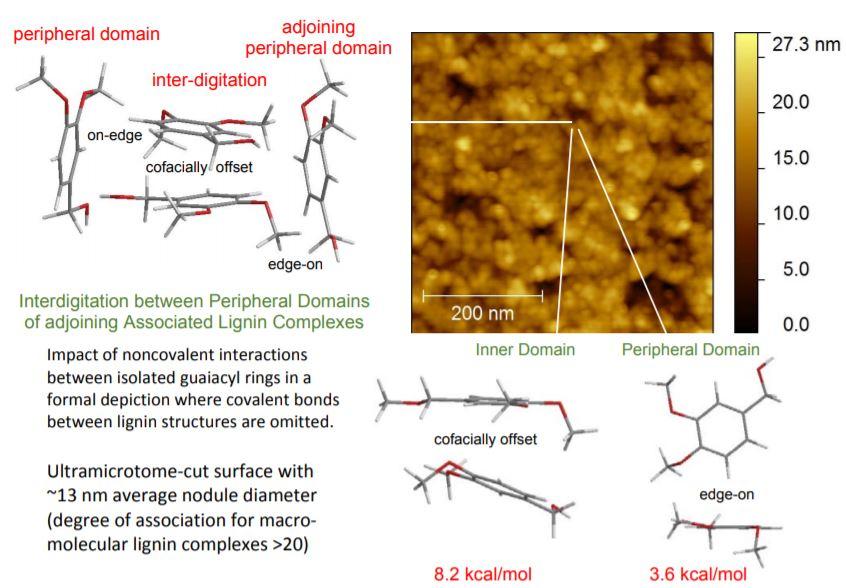Biodegradable Plastics with Lignin Contents above 90 wt%
Biorefineries. Total annual plant growth exceeds 200 billion oven-dry tonnes, 80% of which is manifested in trees. The aromatic biopolymers called lignins contribute over 10% to this primary biomass-production total. Plant biomass is recognized as a potential inventory of renewable starting materials for manufacturing liquid biofuels, chemicals and biodegradable plastics. This vision has led to new processes for creating biorefineries that fractionate lignocellulose (of which plant cell walls are made) into its constituent polysaccharides (cellulose as well as hemicelluloses) and lignin. Despite the many hundreds of millions of dollars invested over the past 12 years in converting plant cell-wall polysaccharides to biofuels like ethanol or diesel-range fatty-acid blendstocks, profitability remains out of reach. Additional value must be gained from plant cell-wall lignins.
Lignin Valorization. The most straightforward way of valorizing lignins would involve their high-level incorporation into functional plastics. However, this has been achieved only very recently. For the past 60 years, there has been enormous resistance to the idea of developing plastics containing very high levels of lignin. The problem arose in 1960 with a working hypothesis that sought to account for the hydrodynamic behavior of lignin components in terms of intermolecular crosslinking within the polymer chains. If correct, the inevitable rigidity of individual lignin macromolecules would have resulted in unavoidable interstices between neighboring molecular entities in materials with very high lignin contents. Actually, lignin preparations are largely composed of well-defined associated complexes instead of individual components. Judicious manipulation of this distinctive feature can lead to a broad range of formulations for functional plastics containing >90 wt% lignin.
Kraft Pulp Mills. The question arises as to what kinds of lignin preparations should be given priority for developing new biodegradable plastics. In the interests of profitability, equivalent “first generation” biorefineries should be high on the list. Thus, in order to make paper, wood chips have been converted into cellulosic fibers for 130 years using the kraft pulping process, which dissolves and transforms much of the lignin in the wood cell-wall lignocellulose. Kraft Lignin-based Plastics. Industrial softwood kraft lignin can be blended with small quantities (~5 wt%) of biodegradable components to produce materials with tensile strengths that surpass polystyrene by a substantial margin (as much as 1.5-fold). In the process, the tensile strength of the kraft lignin-based material on its own increases by more than a factor of 2. It is unusual for small quantities of blend components to have such a dramatic impact on the mechanical properties of a polymeric material.
Associated Lignin Complexes. The integrity of kraft lignin-based plastics depends on the fact that the constituent macromolecular species are not individual components but primarily associated complexes instead. These entities embody inner and peripheral domains in which interacting aromatic-ring orientations are distributed over distinctly different proportions of cofacially offset and edge-on arrangements. The non-lignin blend components interact preferentially with the peripheral domains where interdigitation between aromatic rings inneighboring complexes enables material continuity to be achieved. This is illustrated schematically in the Figure for associated lignin complexes on a 100 wt% methylated ball-milled softwood lignin-based plastic surface.
Future Prospects. The production cost of the new biodegradable kraft lignin-based plastics is expected to be less than half of the selling price of polystyrene. Consequently, the additional kraft lignin made available by increasing production in a recovery-loaded kraft pulp mill can improve operational profitability through earnings from first-generation biodegradable lignin-based plastics. The insights gained by manipulating formulations for compression- and injection molding will contribute to developing biodegradable lignin-based plastics from second-generation biorefineries. The overall prospects are very promising: comparable plastics based on ball-milled softwood lignin and softwood ligninsulfonates have also been developed.
